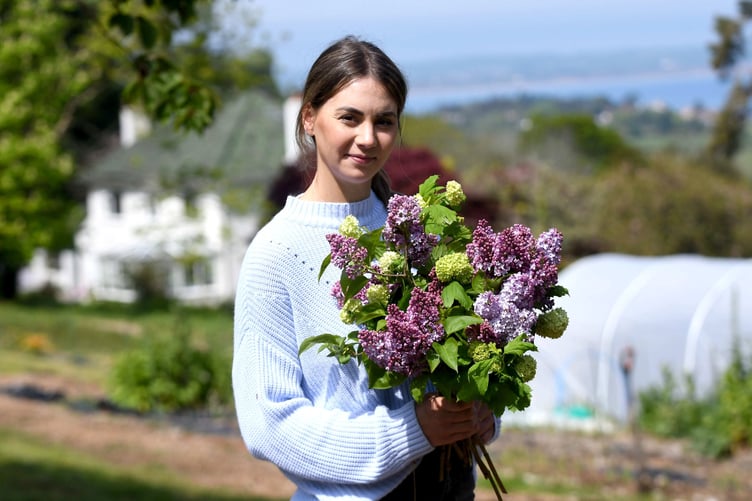In a magical spot, tucked away on the hillside above Maughold, Laura Sayle is growing flowers that are seasonal and local.
She is part of a growing movement of small scale growers supplying flowers in a more sustainable way as more customers are looking for the same values in the flowers that they choose as they do in the food that they buy.
It is estimated that 90% of the flowers sold through florists, supermarkets and wholesalers are imported. They typically come from Holland but can come from as far afield as Ecuador, Colombia, Kenya or Ethiopia.
By contrast, flowers grown by a local flower farmer are not just more sustainable: they will be freshly picked and delivered and will have the quality that comes from the care a small scale grower can give, just as it does with artisan food products.
Laura says: ‘I always thought that I wanted to be a florist and I’d enjoyed gardening in lockdown, as everyone did, and then I did some work over here in a florist’s.
‘I did love it and I learned a lot but it was very much a production line rather than creativity. Flowers to me are all about beauty and seasonality but in a traditional florist it’s very much - “this is the picture, this is what you make, this is what they’ve ordered, these are the colours you’ve got”, so it didn’t really tie together although I did learn a lot in terms of the basics.
‘Then, suddenly, growing British flowers has burst into popularity in recent years. I hadn’t realised that it had become a bit of a thing in the UK but I kind of got on that bandwagon and went from there really, and just decided to give it a go.’
Her business, Meadow & Me, supplies flowers grown without pesticides or chemicals. Flowers in season are sold simply by the bunch or used to create bespoke floral designs for events, weddings and birthdays.
She grows all the flowers at home, in the eight acre garden that surrounds the house: ‘We’re quite sheltered, we don’t often get a frost, although we did have snow twice this year, but we do get a lot of rain and mist,’ she says.
The property was originally owned by a colonel and his wife who were keen gardeners on a grand scale, planting hundreds of now mature trees, along with rhodedendrons and azaleas.
Laura says: ‘There were no flowering perennials it’s all shrubs and trees. That’s how I got started because we moved in in September time and then, coming up to Christmas, there are so many eucalyptus trees here and they really come into their own in winter so I started making Christmas wreaths for friends.’
She now grows a wide range of cut flowers. The tulips have just finished and it’s on to plants including foxgloves, cornflowers, bunny tail grass, achillea, feverfew, astrantia, sunflowers, Canterbury bells, snapdragons, honesty, rudbeckia, nigella and statice.
Later of course there will be roses, dahlias, peonies, sweet peas, lupins and wallflowers.
Laura has a greenhouse for starting off her seedlings and a couple of small polytunnels to use later.
She says: ‘It’s handy to have the polytunnels in the summer, especially when I’m doing weddings and things and I need to guarantee that I have flowers. There’s nothing worse than coming out when it’s rained heavily and everything has flopped over, so the covered space is definitely essential - I’ve learnt that.’
For a successful flower farm there are actually not many flowers to be seen right now and Laura explains that this is usually the case as she picks most of them early in the morning to fulfil orders.
She says: ‘I think when people imagine a flower farm they think about lots of flowers but it’s never like that because I sell any flowers that I have. And it’s very seasonal so each bed gets flipped: for example tulips, which would not have been a display anyway because they’re pulled before they’re in colour, that bed has now been replaced with tiny little cosmos.
‘In July you might get a bit more of a show because things are growing fast but this time of year you never really get that flush of colours and if you do you’re not selling successfully.’
There are other surprises as we take a look at her rose beds. She has planted 250 roses and we are admiring one that is laden with buds.
‘But then I have to do this,’ she says as she nips off half a dozen buds and discards them.
Seeing my look of horror she explains: ‘I have to do that three times a week at this time of year to get the stem length: if you take the buds off you get that extra height.’
Laura employs a no till method on her beds, covering them with landscape fabric or the fleeces from their small flock of pet sheep when they’re not being used. ‘I leave in the previous bed because I try and keep all that goodness in the soil,’ she says.
She is also philosophical about garden pests, including the rabbits that are frequent visitors.
‘They ate a whole bed of ammi recently,’ she says, ‘so I’ll plant out 70% of what I have and leave a tray so I can replace. Once they get to a certain size most things tend not to get bothered.’
She does all the work in the garden herself which means that sometimes she has to take time out from picking and delivering orders: I’ll have a really busy few weeks then I’ll have to get more planted out, otherwise I won’t have anything in the summer, and that means I have to put selling bouquets on the back burner.’
And it’s heartening to know that it’s not just us amateur gardeners who are always learning: the professionals are too.
Laura says: ‘The first year I did this I planted in February, all my seedlings, and I thought “this is going to be great, it’s going to be amazing”. And then it was all gone, and once it’s gone, it’s gone. So it’s all about succession; If you think you’ve done enough, do five times more.’
Because Laura works with nature and the seasons, the flowers she supplies are definitely not ‘off the shelf’.
She says: ‘I don’t work like a traditional florist, I don’t do any promises for flowers when people say: “I want a bouquet of peonies”, because I can’t guarantee that that particular flower is going to be ready.
‘And my colours all tend to be quite muted: there’s definitely a certain bride that will enjoy my wedding flowers and that’s fine with me.’

.jpeg?width=209&height=140&crop=209:145,smart&quality=75)
.png?width=209&height=140&crop=209:145,smart&quality=75)


Comments
This article has no comments yet. Be the first to leave a comment.